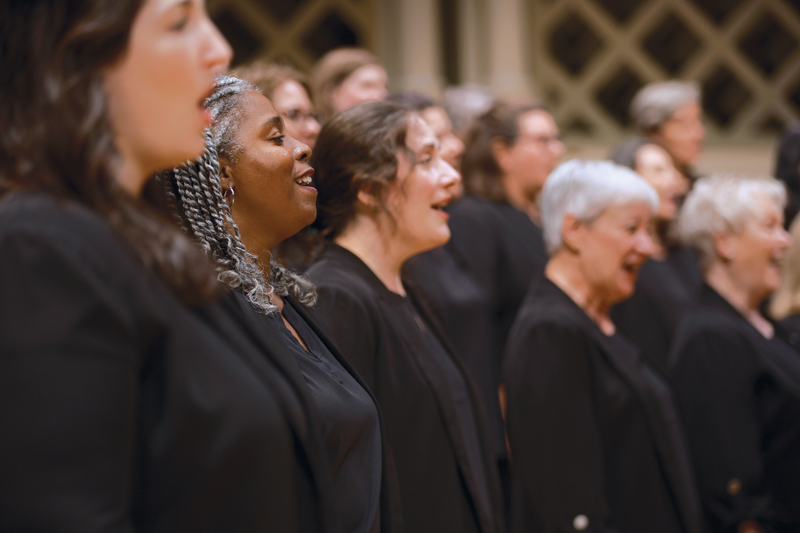Inside the Chorus: The Power of Singing Together

by Tyler M. Secor
In 2019, Chorus America estimated that more than 54 million Americans sang in choruses — more than one in six of all Americans over the age of 18. And the percentage of singing Americans grows with each passing decade. Anecdotally, the ranks of choruses swelled dramatically post-Covid pandemic as people sought community after the long period of isolation.

With so many people participating in choral singing, there must be clear benefits beyond loving to sing or loving choral music.
Research at the intersection between the arts and health/wellness is ever-expanding, especially with the rise of noninvasive methods of studying brain activity. 2025 Festival Director Renée Fleming has curated a nearly 600-page book of essays from “leading scientists, artists, creative arts therapists, educators and healthcare providers about the powerful impacts of music and the arts on health and the human experience.” Music and Mind: Harnessing the Arts of Health and Wellness explores topics such as how to love opera, using music to manage chronic pain, the intersection between music and memory, dance and Parkinson’s, and even “The Potential of Group Singing to Promote Health and Well-Being.”
In her overture to the book, Fleming writes the following about the root of her passion for exploring the intersection between art and health:
The many of us who appreciate, create or perform the arts intuitively understand their therapeutic effects on our lives. For me, experiencing art — whether musical, theatrical, or visual — can invoke bliss, a heart-filling satiation, and the gift of being fully present. Additionally, as a performer, I know well how it can produce a flow state, a sense of being in the zone, with my voice transported on long breaths as I attempt to paint a landscape of sound. As a singer, my body is my instrument, so I [was] … hoping to understand what science could teach me about the biological need to express and create. The ideas I encountered … gave form and language to questions I had long harbored, sparked a passion that is continuing to enrich my life.
Dr. Julene K. Johnson, a cognitive neuroscientist and co-director of the Sound Health Network, noted in her contribution to Music and Mind that group singing led to an overall sense of “feeling good.” As one participant in Johnson’s “Community of Voices” study stated, “The choir — it rejuvenates you. It gives you encouragement, more will to live. Music is medicine for the soul. It’s helped me a lot.”
When Chorus America surveyed singers for their 2019 “The Chorus Impact Study” the results showed that:
- Nearly seven in 10 singers say that singing has helped them socialize better in other parts of their lives.
- 73% of singers reported that choral singing helps them feel less alone or lonely.
- 80% of choral singers expect more good things than bad things to happen to them (compared to 55% of the general public).
- 63% of singers reported that choral singing has made them more open to and accepting of people who are different from them or hold different views.
There is also evidence that, instead of doing the typical ice-breaker or getting-to-know-you activities at gatherings like corporate retreats, attendees should try singing together. Research published by Royal Society Open Science reports the “first evidence for an ‘ice-breaker effect’ of singing in promoting fast cohesion between unfamiliar individuals,” noting that “singing breaks the ice so that individuals feel closer to the group as a whole even if they do not yet know anything about the individual members. Such an effect may overcome time constraints on the creation of individual relationships to allow large human groups to coordinate effectively and quickly.”

Research published in Evolution and Human Behavior suggests that choral singing not only encourages close social bonding but it also is effective at relieving pain, by stimulating an increase in pain thresholds. Similarly, music therapist Dr. Joke Bradt’s essay, “Music for Chronic Pain Management” found within Music and Mind, states that “a survey of music listening habits in 318 people with chronic pain found that those who engaged more frequently in listening to music, and for whom music was important, reported better quality of life and needed less medical treatment.”
As you listen to the May Festival Chorus sing Igor Stravinsky’s Symphony of Psalms or Giuseppe Verdi’s Requiem watch how the singers breathe together and how deeply they breathe to create their sound. Respiratory sinus arrhythmia is the clinical term for the “physiologic change in heart rate synchronized with respirations, so that the heart rate increases with inspiration and decreases with expiration” (Cardiac Electrophysiology Clinics). The link between breathing and heart rate suggests that, as singers sing in unison, they breathe together and thus speed up and slow down their heart rates together, thereby creating a bond at a biological level.
For older adults, singing in a chorus can help to maintain cognitive abilities and improve chronic health conditions. Eight in 10 older (65+) choral singers report that singing has kept their mind sharper, and 20% reported that choral singing helped to relieve or improve one or more chronic health conditions (Chorus America).
Although this is just the tip of the research iceberg when it comes to the benefits of singing and singing together, it is clear there is power in choral singing, with positive impacts both on singers’ mental health and their physical wellbeing. As we learned all too well from the mental health effects that came from the pandemic, we are social beings. Singing together helps us understand each other and feel safe with one another. Working together to create music from our lungs soothes our souls and our bodies.